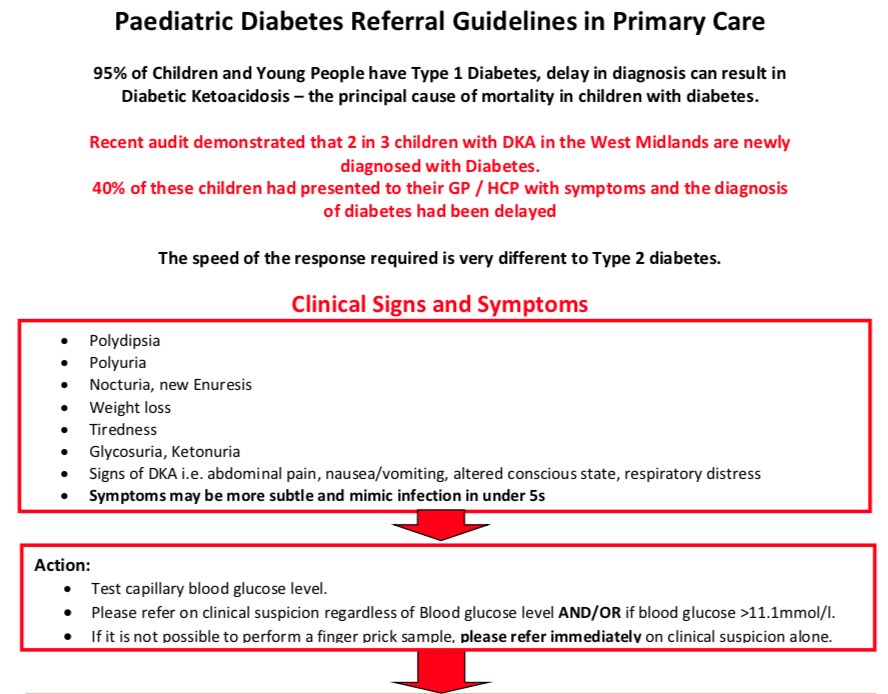


Coventry Guidance 
Prescribing For Paediatric Patients with Type 1 Diabetes
Blood Glucose Monitoring (usually Aviva Expert meter):
Need to test at least 5 times a day as a minimum (often test 6-8 times per day).
Need up to 300 strips and lancets per month quantity unrestricted.
Blood sugars are very variable depending on activity levels and food intake with insulin doses adjusted appropriately.
When using the Freestyle Libre device smaller stock of blood glucose strips needed.
It is also recommended that additional finger prick testing is carried out if Libre readings do not match clinical symptoms e.g. if they look like they are low
Blood ketone monitoring (usually FreeStyle Optium Neo meter):
Test for ketones if blood sugar goes above 14 (frequently when newly diagnosed).
30 or more ketone strips per month may be needed (unrestricted).
The ketone meter supplied to patients is also a back-up meter for blood sugars should their main meter fail.
Single packs of blood glucose strips may occasionally be requested for this meter.
The same lancing device can be used for glucose and ketone monitoring.
Insulin
Requirements guided by the patient/parents on insulin dose per month.
Insulin needles
Patients will generally be having at least 4 insulin injections per day, therefore will need 200 needles per prescription.
At home, the standard Tricare needles can be used, but when at school there is a requirement that safety needles are used (e.g. BD Autoshield), therefore the patient may have two different brands of needle on repeat.
Safety needles may also be recommended for patients with a needle phobia.
Sharps Boxes
All patients are given information from UHCW on how to dispose of sharps boxes.
GP surgeries should not accept sharps boxes for disposal but should direct patients to their local council service:
- Coventry City Council: wastesolutions@coventry.gov.uk , Tel: 024 7683 2255
- Rugby Borough Council: contact.centre@rugby.gov.uk , Tel: 01788 533 533 (Clinical Waste Team)
Replacement sharps boxes should be prescribed for patients on request.
They will usually need one for school and one for home (if living in a separated family, they may need one for each parent’s home). The Sharpsafe 7 litre yellow bin is recommended but patients may request other sizes depending on the devices they are using. They may prefer a smaller sharps bin for school.
Glucagon
Keep glucagon at home in case of emergency (but NOT at school, unless going on a residential trip).
Parents are trained how to use this by UHCW diabetes specialist nurses.
Please add glucagon to the patient’s repeat medication list even if only ordered infrequently, in the form of the GlucaGen hypo kit.
Glucose products
LIFT Glucose Tablets (formerly Glucotabs) are needed for mild or moderate hypos; they should be carried by the patient at all times in case of low sugars, and patients may need spare packs to keep at school, in the car etc.
They come in individual refillable packs of 10 tablets, or a bulk refill pack of 50 tablets.
Usually the more convenient 10-packs will be requested by the patient. Quantities required per month may vary greatly but please ensure these products remain on the patient’s repeat list so they can request as needed.
Occasionally the specialist clinic may recommend prescribing Lift Glucojuice if children are unable to chew the tablets.
GlucoBoost 40% gel is used for moderate hypos. It is available in a pack of 3 x 25g tubes (comes up on EMIS as 75g pack size). Please supply one pack at a time.
Reviews
Patients are reviewed by the diabetes specialist team every 3 months.
Medication is reviewed at every appointment and parents may be reluctant to bring patients to the GP surgery for a medication review.
A telephone review of hospital letters and a telephone conversation with the parent may be sufficient.
On EMIS systems for items requested less frequently such as Glucagon, it may be helpful to put them onto the medication list as a ‘variable use repeat’ (select ‘repeat’ as Rx type and then tick ‘variable use’ box in ‘add medication’ screen – it will then go into a separate section on EMIS).
Summary
| Product | Purpose | Usual quantity *this will vary from patient to patient* |
| Blood glucose test strips | Regular blood glucose monitoring | 300 per month |
| Blood ketone testing strips | Blood ketone check if blood glucose over 14 | 30 per month |
| Lancets | New lancet to be used for each blood glucose/ ketone test | 300 per month |
| Insulin | Treatment of diabetes | As requested by patient |
| Insulin needles | New needle to be used for each insulin injection | 200 per month |
| Sharps box | Safe disposal of sharps | 7 litre size, 2 per prescription or as requested by patient. Patient may request smaller bin for school. |
| Glucagon injection | For emergency use in severe hypo | Not a regular repeat but replace when requested by patient |
| Lift Glucotabs | For treatment of mild or moderate hypos | 4 x10-pack, or as requested by patient |
| GlucoBoost 40% gel | For treatment of moderate hypos | 3x25g (75g pack) |
This guide has been compiled by the Paediatric Diabetes Specialist Nurses at UHCW and the Medicines Optimisation Team at CRCCG, to help explain the prescriptions that may be requested for paediatric patients with Type 1 Diabetes.

Leave feedback
You must be logged in to post a comment.